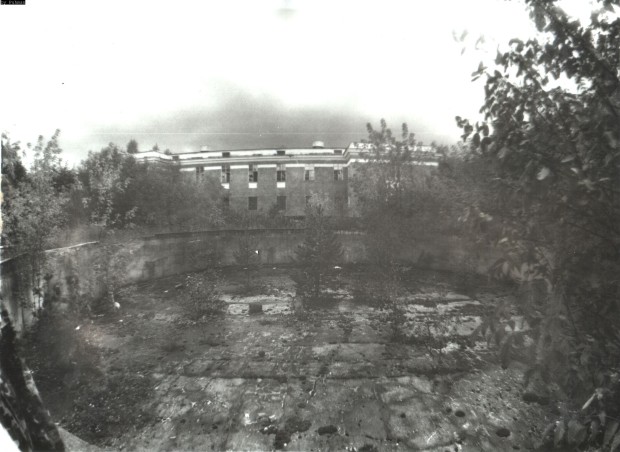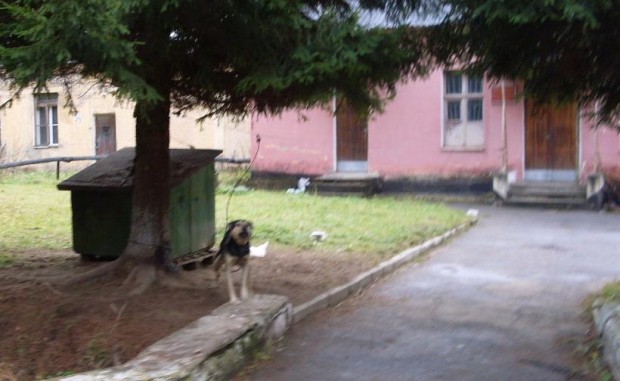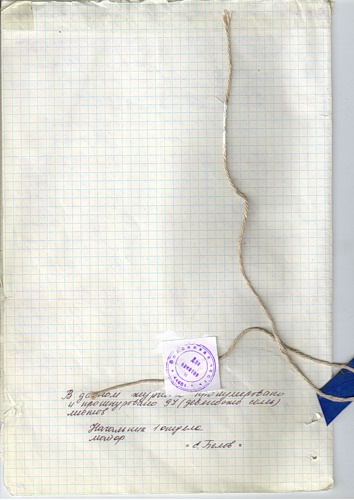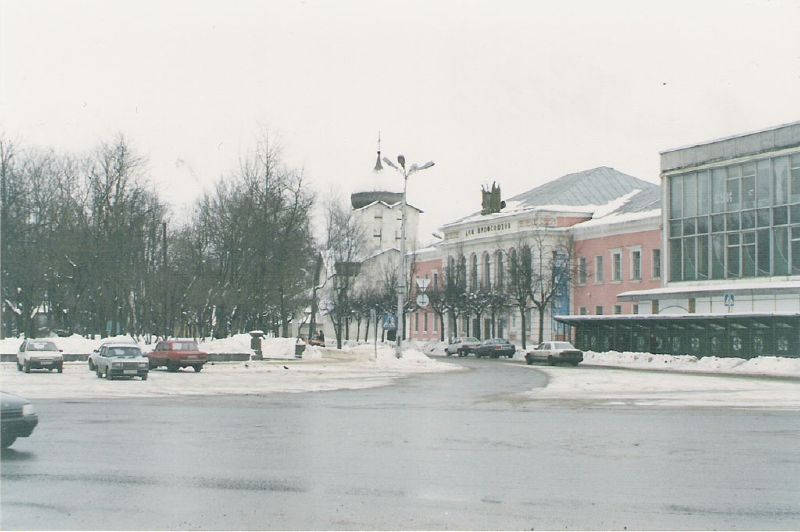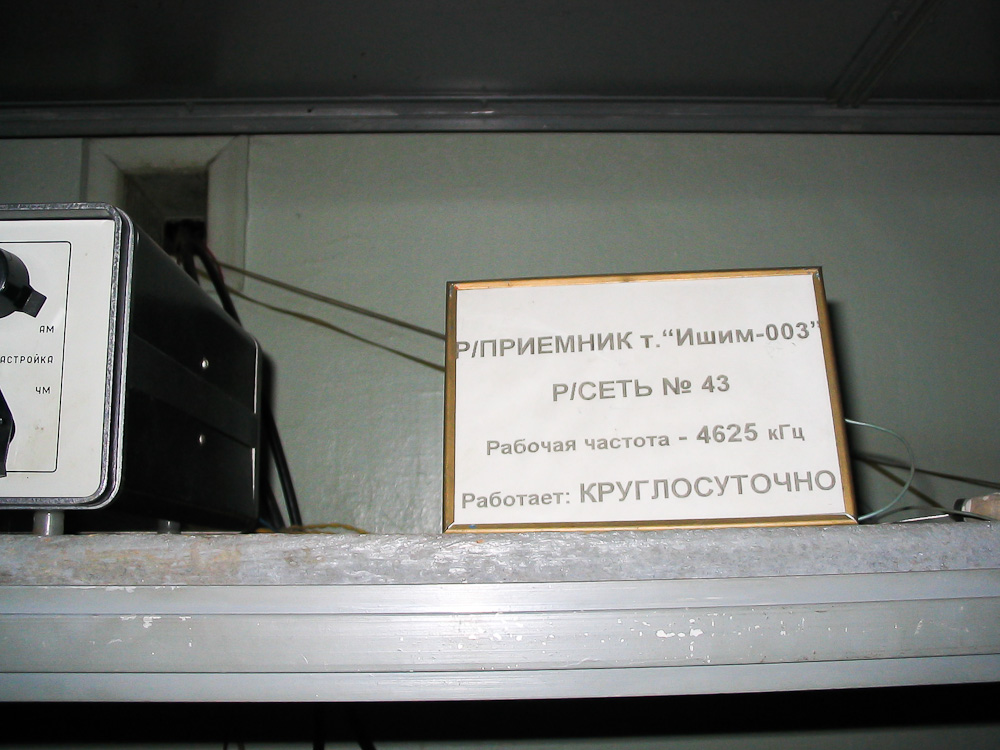|
|
||||||
|
And Most Of Europe! "The Buzzer" UVB-76 56°5′0″N 37°6′37″E (original)
UVB-76, also known as The Buzzer, is the nickname
given by radio listeners to a shortwave radio station
that broadcasts on the frequency 4625 kHz. It
broadcasts a short, monotonous About this sound buzz
tone (help·info), repeating at a rate of approximately
25 tones per minute, for 24 hours per day. On very
rare occasions, the buzzer signal is interrupted and a
voice transmission in Russian takes place. The first
reports were made of a station on this frequency in
1982. Its origins have been traced to Russia, and
although several theories with varying degrees of
plausibility exist, its actual purpose has never been
officially confirmed and remains a source of
speculation.
This is the most COMPLETE and CLEAREST UVB-76
message recording. We hear EVERYTHING perfectly. The
nature of these messages is unknown, but it was once
said that they are to make sure that the receiving
station is prepared. This could mean that the morse
code messages are the real messages, and these are
just tests, but that's what I think.
TEXT: UVB-76, UVB-76, 93, 882, NAIMINA, 74, 14, 35, 74, 9, 3, 8, 8, 2, Nikolai, Anna, Ivan, Mikhail, Ivan, Nikolai, Anna, 7, 4, 1, 4, 3, 5, 7, 4. UVB-76, UVB-76, 93, 882, NAIMINA, 74, 14, 35, 74, 9, 3, 8, 8, 2, Nikolai, Anna, Ivan, Mikhail, Ivan, Nikolai, Anna, 7, 4, 1, 4, 3, 5, 7, 4. Name
The station is commonly referred to as the Buzzer
among English-speaking radio listeners, while Russian
listeners refer to it as жужжалка (žužžalka) – "the
buzzer". Its official name is not known, although some
of the voice transmissions have revealed names which
may be call signs or another form of identification. Up
until September 2010, the station identified itself as
UVB-76 (Cyrillic: УВБ-76), and it is still often
referred to by that name. In September 2010, the
station moved to another location, and it has used the
identification MDZhB (Cyrillic: МДЖБ, phonetic
spelling "Mikhail Dmitri Zhenya Boris") from then
onwards. It has been suggested that the
correct identification until September 2010 was
actually UZB-76 (Cyrillic: УЗБ-76), and that the
Cyrillic letter Ze (З) had been misheard as the letter
Ve (В). However, it is still referred to as "UVB-76"
by most people. Although the station, by and large,
has used these two codes at the beginning of most
voice transmissions, a few voice messages have used
other identification codes. This makes it uncertain
whether the names are actually the call sign of the
station, or some other identifying code.
 The Buzzer - A
short clip of UVB-76's transmission as heard in
Southern Finland, 860 km (530 mi) away from the
station in 2002. The Buzzer - A
short clip of UVB-76's transmission as heard in
Southern Finland, 860 km (530 mi) away from the
station in 2002.Format The station transmits using AM with a suppressed
lower sideband (R3E), but it has also used full
double-sideband AM (A3E). The signal consists of a
buzzing sound that lasts 1.2 seconds, pausing for
1–1.3 seconds, and repeating 21–34 times per minute.
Until November 2010, the buzz tones lasted
approximately 0.8 seconds each. One minute before the
hour, the repeating tone was previously replaced by a
continuous, uninterrupted alternating tone, which
continued for one minute until the short repeating
buzz resumed, although this no longer occurs since
June 2010.
The Buzzer has apparently been broadcasting since at least 1982 as a repeating two-second pip, changing to a buzzer in early 1990. It briefly changed to a higher tone of longer duration (approximately 20 tones per minute) on January 16, 2003, but it has since reverted to the previous tone pattern.
A spectrum for UVB-76 showing the
suppressed lower sideband.
Voice messages On rare occasions, the buzzing sound is
interrupted and a voice message is broadcast. These
messages are usually given in Russian by a live voice,
and follow a fixed format.
Until 2010, voice messages were thought to be very rare. Examples of such messages include: At 2100 UTC on December 24, 1997: "Ya UVB-76, Ya UVB-76. 180 08 BROMAL 74 27 99 14. Boris, Roman, Olga, Mikhail, Anna, Larisa. 7 4 2 7 9 9 1 4." At 0418 UTC on December 9, 2002: "UVB-76, UVB-76. 62 691 IZAFET 36 93 82 70" At 0757 UTC on February 21, 2006: "UVB-76, UVB-76. 75-59-75-59. 39-52-53-58. 5-5-2-5. Konstantin-1-9-0-9-0-8-9-8-Tatiana-Oksana-Anna-Elena-Pavel-Schuka. Konstantin 8-4. 9-7-5-5-9-Tatiana. Anna Larisa Uliyana-9-4-1-4-3-4-8." During 2010, listeners reported increased activity of the station, which spurred on further monitoring and allowed listeners to "catch" more of the messages which would have otherwise gone unnoticed. On June 5, 2010, UVB-76 went silent for approximately 24 hours, resuming the normal buzzing pattern on the morning of June 6. At 1335 UTC on August 23, 2010 a voice message was broadcast: "UVB-76, UVB-76. 93 882 NAIMINA 74 14 35 74" (Recording of August 23rd transmission) Two days later, on August 25 at 0713 UTC, the signal went silent again, followed by a series of thumping sounds apparently in the same room as the open microphone. It was followed by a hail of electronic noise, which then faded again into the buzzer broadcast. Later that same day, voices were heard conversing loudly behind the buzzer. Another voice broadcast was made at 1648 UTC on September 7: "Mikhail Dmitri Zhenya Boris. Mikhail Dmitri Zhenya Boris. 04 979 D-R-E-N-D-O-U-T. T-R-E-N-E-R-S-K-I-Y." It was the first of 25 voice messages that would be broadcast by September 30, with another 56 to follow between October and December. Each of these, with one exception on September 10, replaced the familiar "UVB-76" call sign with "MDZhB", suggesting that the station had changed call signs. A further 14 voice messages followed between January 5 and February 5, 2011. On March 18, 2014, less than 24 hours after Crimea voted to join the Russian Federation, a new voice message was recorded: "T-E-R-R-A-K-O-T-A. Mikhail Dimitri Zhenya Boris. Mikhail Dmitri Zhenya Boris. 81 26 T-E-R-R-A-K-O-T-A." The message was repeated again followed by the buzzer resuming. On December 3, 2014 at 22:44, the buzzer tone pitched down over about 7 seconds, making a 'dying' noise, and went silent afterwards, but the buzzer resumed about 10 minutes later. Unusual transmissions Frequently, distant conversations and other
background noises have been heard behind the buzzer,
suggesting that the buzzing tones are not generated
internally, but are transmitted from a device placed
behind a live and constantly open microphone. It is
also possible that a microphone may have been turned
on accidentally. One such occasion was on November 3,
2001, when a conversation in Russian was heard:
"Я – 143. Не получаю генератор." "Идёт такая работа от аппаратной." ("I am 143. Not receiving the generator (oscillator)." "That stuff comes from hardware room."). On November 11, 2010, intermittent phone conversations were accidentally transmitted and were recorded by a listener (at 1400 UTC) for a period of approximately 30 minutes. These conversations are available online, and seem to be in Russian. The phone calls mentioned the "brigade operative officer on duty", the communication nodes "Debut", "Nadezhda" (Russian for "hope", both a noun and a female name), "Sudak" (a kind of river fish and also a town in Crimea) and "Vulkan" (volcano). The female voice says "officer on duty of communication node Debut senior ensign Uspenskaya, got the control call from Nadezhda OK". Location and function The purpose of the station has not been confirmed
by government or broadcast officials. However, the
former Minister of Communications and Informatics of
the Republic of Lithuania Rimantas Pleikys has written
that the purpose of the voice messages is to confirm
that operators at receiving stations are alert. Other
claims are that the broadcast is constantly being
listened to by military commissariats.
There is speculation published in the Russian Journal of Earth Sciences which describes an observatory measuring changes in the ionosphere by broadcasting a signal at 4625 kHz, the same as the Buzzer. However, this would not explain the voice messages. It is also speculated that the voice messages are some sort of Russian military communications, and that the buzzing sound is merely a "channel marker" used to keep the frequency occupied, thereby making it unattractive for other potential users. The author does not explain the continued expenditure on this public transmission for such a small trickle of usable information, particularly with the advent of cheap, reliable, secure communication via the Internet. It is worth noting that this transmission has been maintained consistently and at high power for over 30 years. There are two other Russian stations that follow a similar format, nicknamed "The Pip" and "The Squeaky Wheel". Like the Buzzer, these stations transmit a signature sound that is repeated constantly, but is occasionally interrupted to relay coded voice messages. The former transmitter was located near Povarovo, Russia at 56°5′0″N 37°6′37″E which is about halfway between Zelenograd and Solnechnogorsk and 40 kilometres (25 mi) northwest of Moscow, near the village of Lozhki. The location and callsign were unknown until the first known voice broadcast of 1997. In September 2010, the station's transmitter was moved to near the town of Pskov. This may have been due to a reorganization of the Russian military. In 2011 a group of urban explorers explored the abandoned buildings at Povarovo. They claim that it is an abandoned military base. A radio log record was found, confirming the operation of a transmitter at 4625 kHz. UVB-76 Wikipedia |
||||||
|
Has
the Internet solved the mystery of this
40-year-old radio signal?
Volume dials were turned up, computers began
recording, forum posts were hastily typed. Something
big was happening.
OBYaVLENIYA KOMANDA 135 For the first time in a history that stretches back nearly 40 years, the mysterious Russian radio signal popularly known as UVB-76 had issued an order. On Jan. 24, 2013, it was heard clearly by its legion of fans: Command 135 initiated The radio signal that occupies 4625 kHz has reportedly been broadcasting since the late 1970s. The earliest known recording of it is dated 1982. Ever since curious owners of shortwave radios first discovered the signal, it has broadcast a repeating buzzing noise. Every few years, the buzzer stops, and a Russian voice reads a mixture of numbers and Russian names. A typical message came hours before Christmas day, 1997: “Ya UVB-76, Ya UVB-76. 180 08 BROMAL 74 27 99 14. Boris, Roman, Olga, Mikhail, Anna, Larisa. 7 4 2 7 9 9 1 4” Instead of shutting down with the fall of communism in Russia, UVB-76 became even more active. Since the millennium, voice messages have become more and more frequent. It’s easy to dismiss the signal as pre-recorded, or a looping tone. But what listeners quickly realized was that UVB-76 is not a recording. The buzzer noise is generated manually. The reason for hearing telephone conversations and banging noises in the background of the signal is that a speaker creating the buzzer is constantly placed next to the microphone, giving the world an eerie insight into whatever cavern the signal originates from. The modern popularity of UVB-76 can be traced to /x/, 4chan’s non-archiving message board devoted to discussion of paranormal activity and unexplained mysteries. Just as 4chan created memes like Pedobear and Rickrolling, the online image board served to bring UVB-76 before the eyes of a host of Internet users. Online chatter about the signal increased in 2010 as bizarre broadcasts were issued on an almost monthly basis. Snippets of Swan Lake were played, a female voiced counted from one to nine, a question mark was transmitted in Morse code, and strange telephone conversations were overheard by the receiver. Since October 2010, the station has changed location. The flurry of activity and voice messages preceded the most important development in the signal since it began broadcasting in the 1970s. It seems likely that the heightened activity of 2010 was related to the establishment of the signal in a new location. The new call sign was read out after the move: “MDZhB”. Previous triangulation efforts had led to the discovery of the transmitter for UVB-76: a Russian military base on the outskirts of Povarovo, a small town 19 miles from Moscow. After the station changed location, two groups of urban explorers and UVB-76 followers travelled to the remote Russian town in an attempt to visit the military bunker that the signal had originated from for over 30 years. When they reached the town, a local man told them about the storm of 2010. One night a dense fog rolled in, and the military outpost was evacuated within 90 minutes.
THE
RUSSIAN MILITARY OUTPOST THAT UVB-76 OPERATED FROM
UNTIL 2010. IMAGE BY ’BYDUNAIKA’
After making their way across the site and
avoiding the guard dog stationed outside, the groups
found the bunker and military buildings in a state of
abandonment. Possessions and equipment were strewn
across the base. Icy water had filled the bunker, yet
clues were still to be found inside. One group
described the Povarov military bunker as "a quiet and
lonely dark place, something like a maze with lots of
corridors and rooms."
THE GUARD
DOG STATIONED OUTSIDE THE POVAROVO MILITARY
COMPOUND. IMAGE BY ‘DESERT_FOX’
A book was found that contained a log of messages
sent by UVB-76. The ethereal signal that had
fascinated the world for years now had a physical
presence, along with confirmation that it had been run
by the Russian military.
THE UVB-76
LOGBOOK DISCOVERED BY‘BYDUNAIKA’
But the mystery continues to this day. Sporadic voice
messages are still emitted. Legions of listeners tune
in via radios and online streams every day. A file can
be downloaded at this link that allows followers to
listen to UVB-76 in iTunes.
Along with a renewed interest in studying and archiving the broadcasts of UVB-76, multiple triangulation attempts have been made to try and ascertain the new location of the signal. Unlike before, it seems that UVB-76 is emanating from multiple transmitters across Russia. Triangulation has given rise to three possible locations. One possible location is the small Russian village of Kirsino, which has a registered populace of just 39 people. One signal can be traced here. But this isn't the fan-favorite location.
KIRSINO, THE
REMOTE RUSSIAN VILLAGE THAT MAY HOLD CLUES TO THE MEANING
OF UVB-76.
IMAGE FROM THE OFFICIAL KIRSINO WESBITE.
Near to the Estonian border lies the Pskov
Oblast. This is currently the most likely source of
UVB-76, due to the multiple triangulation attempts
that lead here.
PSKOV,
THE ADMINISTRATIVE CENTER OF PSKOV OBLAST, 2003.
Photo via Sergey Rodovnichenko/Flickr (CC BY S.A 2.0) Recently a new theory has been the cause of much
discussion amongst the followers of UVB-76. Could the
signal be related to the Russian Government radio
channel Voice Of Russia? One location that appears
during triangulation attempts is very close to a
transmitter array southeast of Kolpino that is
reportedly used by the Russian government to transmit
state radio across Russia.
As UVB-76 settled into the new location, Dance of The Little Swans from Swan Lake was played. Instrumental passages from Swan Lake are a favorite of Voice Of Russia.  The
radio array that offers an intriguing link
between UVB-76 and the Russian government
While Internet followers may have discovered the
location of the old signal, the purpose of UVB-76
remains a mystery. As with any unexplained mystery,
conspiracy theories abound, some more credible than
others.
The closest thing to an official explanation for the signal’s purpose comes from an academic paper published by the Borok Geophysical Observatory. This state-funded organization describes itself as a "branch of the Federal state budgetary institution of science." They explain that the signal originates from an observatory using the 4625 kHz frequency to measure changes in the ionosphere. This does not explain the military bunker, or the voice messages. Nor does the paper detail how successful the research has been. A signal on the 4625 kHz frequency would have suffered from extreme interference, rendering it nearly unusable for researching the ionosphere. The fan-favorite conspiracy is that UVB-76 is the audible version of Russia’s "Dead Man Switch" system. In the case of a nuclear strike that cripples Russian military command, the automated system will launch a counter-strike. While it’s likely that Russia does possess such a system, it’s fanciful to think that this humble buzzing sound is the noise of our impending nuclear apocalypse. The most credible explanation of UVB-76’s purpose is that it is a military communication system operating across western Russia. The coded messages are announcements for various military districts, enabling a simple means of communicating with multiple units at the same time. As for the repeating buzzing noise, this is thought to be a channel marker that exists to discourage others from using the same frequency. An image posted on Russian Wikipedia seems to confirm the military communication theory. A small, framed piece of paper in an administration and enlistment office of the Russian army refers to 4625 kHz, the broadcasting frequency of UVB-76. With this so prominently displayed, it’s possible to confirm that the signal is not a "Dead Man’s Switch," nor is the signal intended to be a secret. The Internet has, for decades, been listening to the internal communication network of the western division of the Russian armed forces.
CAPTION: A SIGN IN A RUSSIAN MILITARY
ENLISTMENT OFFICE THAT REFERENCES THE 4625 KHZ
FREQUENCY USED BY UVB-76. Photo via Orlando
Avare/Wikipedia
While the mystery of UVB-76 may have been solved, its
legion of followers and obsessives will continue to
listen. Thousands of people across the world tune into
the signal, hoping to catch one of the ethereal voice
messages.
For those in the know, it’s a bemusing social phenomenon. But for the residents of 4chan’s /x/ board and the radio scanner fans, UVB-76 is far more than a communications network. For them, it’s a sign of the forthcoming apocalypse, it’s an international spy network, it’s a secret Russian space experiment. Whether you believe the theories or not, there’s no denying the thrill that comes with hearing the distorted voice messages of UVB-76. Has the Internet solved the mystery of this 40-year-old radio signal? A Russian Enigma - UVB-76 |
||||||
|
References:
External links |
||||||
| FAIR USE NOTICE: This page contains copyrighted material the use of which has not been specifically authorized by the copyright owner. Pegasus Research Consortium distributes this material without profit to those who have expressed a prior interest in receiving the included information for research and educational purposes. We believe this constitutes a fair use of any such copyrighted material as provided for in 17 U.S.C § 107. If you wish to use copyrighted material from this site for purposes of your own that go beyond fair use, you must obtain permission from the copyright owner. | ||||||
|
|


